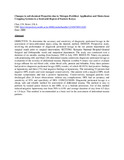| dc.contributor.author | Chui, J.N | |
| dc.contributor.author | Keter, J.K.A | |
| dc.date.accessioned | 2013-02-26T10:08:06Z | |
| dc.date.issued | 2000 | |
| dc.identifier.citation | International Journal olllioChcmiPhysics, Vbl(l 0). 2000 | en |
| dc.identifier.uri | http://erepository.uonbi.ac.ke:8080/xmlui/handle/123456789/11620 | |
| dc.description.abstract | OBJECTIVE: To determine the accuracy and sensitivity of diagnostic peritoneal lavage in the assessment of intra-abdominal injury using the dipstick method. DESIGN: Prospective study, involving the performance of diagnostic peritoneal lavage in the out patient department and surgical wards prior to surgical intervention. SETTING: Kenyatta National Hospital-General Surgical and Orthopaedic wards and outpatient department. The study was conducted over a duration of six months, starting from January 1995 to July 1995. RESULTS: Ninety six patients with penetrating (68) and blunt (28) abdominal trauma underwent diagnostic peritoneal lavage as evaluation of the severity of abdominal trauma. Dipstick (combur 9 strips) was used to evaluate lavage effluent for red blood cells, white blood cells, protein and bilirubin. Forty three patients had positive diagnostic peritoneal lavage (DPL) results, of which 40 (93%) had positive findings at laparatomy and three (7%) had negative findings at laparatomy. The remaining 53 patients had negative DPL results and were managed conservatively. One patient with a negative DPL result became symptomatic and had a positive laparatomy. Conservatively managed patients were discharged after 24 hours observations without any complications. DPL had an accuracy and sensitivity of 93% and specificity of 98%. CONCLUSION: Diagnostic peritoneal lavage is a cheap, safe and reliable method for assessment of abdominal trauma. The method is easy to perform by trained junior doctors in the OPD, or as a bedside procedure. Use of this method reduced negative laparotomy rate from 50% to 6.9% and average duration of stay from 6.5 days to 1.9 days. This method is recommended as a basic tool in the assessment of abdominal trauma patients. | en |
| dc.language.iso | en | en |
| dc.subject | soil chemical Properties | en |
| dc.subject | Nitrogen Fertilizer | en |
| dc.subject | Semi-arid Region of Eastern Kenya | en |
| dc.title | changes in soil chemical Properties due to Nitrogen Fertilizer Application and Maize-bean Cropping Systems in a Semi-arid Region of Eastern Kenya | en |
| dc.type | Article | en |
| local.publisher | Dept of Soil Science, University of Nairobi | en |

